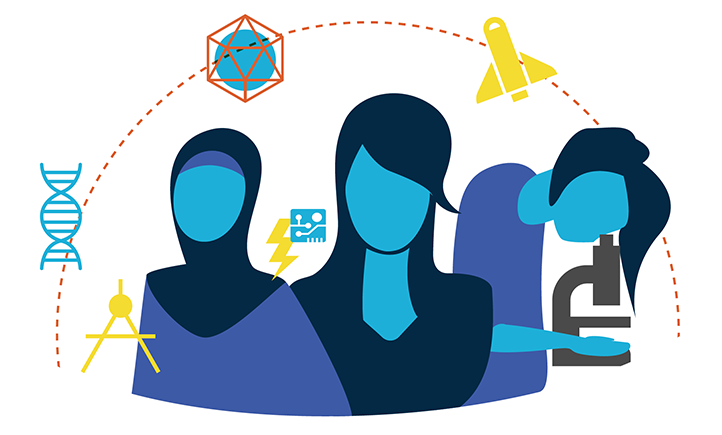“Who Runs The World?” Girls in STEM!
The University of California San Diego’s study on women in STEM showed that, in 2018, men held 8,361,019 jobs in Science, Technology, Engineering, and Math (STEM) fields, while only 2,891,391 women held jobs in these fields. This staggering difference leaves us with one question: why are there three times as many men in comparison to women who make up this workforce?
The answer is not hard to find; stereotypes have been cemented after centuries of STEM fields being viewed as masculine—causing adults to underestimate girls’ abilities in math, starting as early as preschool. Furthermore, since girls have fewer role models to inspire their interest in these fields, seeing limited examples of female scientists and engineers in books, media, and popular culture lower their motivation to pursue a career in STEM.
Because fewer women study and work in STEM, these fields tend to normalize exclusionary, male-dominated cultures that are not supportive of women and minorities. An example of this is seen in 22-year-old Claire “Cleasel” McDonald’s TikTok video of a Zoom work meeting she joins with the caption “live footage of being a woman in stem.”
The meeting consists of a group of four women and almost sixty men. While attempting to share her ideas with the group, she finds that it is nearly impossible to talk when her male co-workers continue to interrupt her at all costs.
McDonald tells Buzzfeed News, “Some of us girls have the top standings in the program, and no matter how experienced we are, none of the men seem to take us seriously.”
This experience from a graduate science and finance program at the University of Iowa represents just one of many inequalities that exist in a woman’s everyday life at a STEM workplace.
These problems are not confined to the workplace; they exist here, at Harriton. In Harriton’s Computer Science Club Zoom meetings, I am the only girl in a meeting with 15 other boys.
While I have not received the same treatment as McDonald did, my experience in being the sole participating female member of the club gives me an insight into what my future may look like as a female working in the technology industry.
There may be hope, however, as people have worked and are still working to close the gender gap in these fields. The majority of women participating in STEM jobs are in the area of Social Sciences, where they take up about half of the employment.
The website of Wellesley Centers for Women wrote about this workforce saying, “Social scientists, especially women…have played a crucial yet unsung role in bringing us closer to our shared ideals of gender equality, social justice, and human wellbeing.”
Without these subtle heroes, women may not have as much freedom as they do today.
Providing a various number of computer classes in clubs, high schools, and colleges also have an effect on bringing more women into computer science. Today, a number of organizations and companies are trying to raise these numbers.
One of them is Women Accelerating Tomorrow, which contains a variety of programs and tools as part of an effort to attract, develop, and keep diverse talent in an engineering-focused and technical industry. The international non-profit organization Girls Who Code, which is a club available to students at Harriton, strives to educate girls on technology using resources some of these soon-to-be coders could never acquire where they live.
In addition to this club, Harriton has increased the number of computer science classes they offer over the past few years. Now, instead of just one class with one topic, there are more than six different classes to learn about all kinds of engineering and computer topics. Because of this variety, more female students can build an interest in computer science.
The effects of the movement to encourage women to join STEM fields are obvious. Even though the number of women compared to men in STEM fields is still low, it has already raised a substantial amount compared to past years. There are more women than ever represented in the STEM workforce currently, and the graphs represented by UCSD’s study help to show this. In the below figure, there is still an obvious gap between the orange (female) and blue (male) lines, but it is hard to not notice that the women in STEM jobs have grown by a million already. 
This graph suggests that the more we start providing new resources and taking proactive measures to introduce and educate STEM fields to women, the closer we are to closing the gender gap in the science and tech workforce.

Sasha is a senior who is ecstatic to spend her fourth and final year writing for the Banner as Business Editor. When she is not writing, Sasha fills her...


